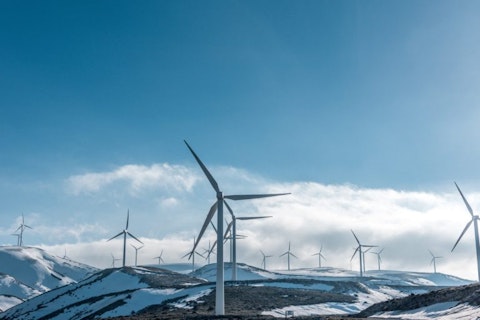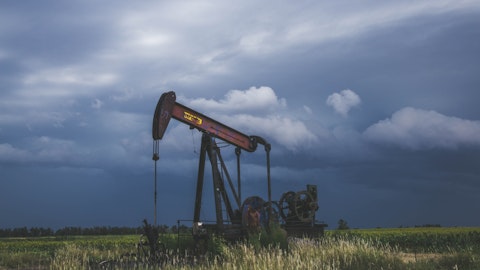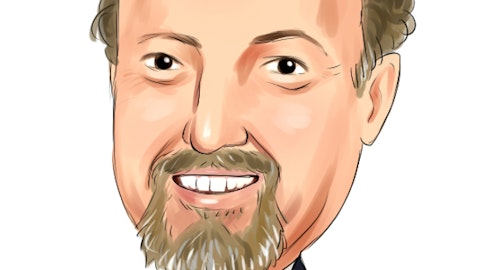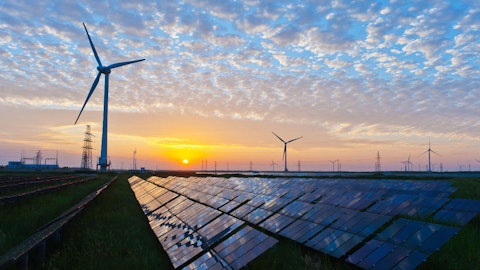Devon Energy Corporation (NYSE:DVN) Q4 2022 Earnings Call Transcript February 15, 2023
Operator: Welcome to Devon Energy’s Fourth Quarter Earnings Conference Call. At this time, all participants are in a listen-only mode. This call is being recorded. I would now like to turn the call over to Mr. Scott Coody, Vice President of Investor Relations. Sir, you may begin.
Scott Coody: Good morning. And thank you to everyone for joining us on the call today. Last night we issued an earnings release and presentation that cover our results for the quarter and our outlook for Devon in 2023. Throughout the call today, we will make references to the earnings presentation to support prepared remarks, and these slides can be found on our website. Also joining me on the call today are Rick Muncrief, our President and CEO; Clay Gaspar, our Chief Operating Officer; Jeff Ritenour, our Chief Financial Officer; and a few other members of our senior management team. Comments today will include plans, forecasts and estimates that are forward-looking statements under U.S. securities law. These comments are subject to assumptions, risks and uncertainties that could cause actual results to differ materially from our forward-looking statements.
Please take note of the cautionary language and risk factors provided in our SEC filings and earnings materials. With that, I’ll turn the call over to Rick.
Rick Muncrief : Thank you, Scott. It’s great to be here this morning. We appreciate everyone taking the time to join us. On the call today, I will cover three key topics: our record-setting performance in 2022, the strong outlook we have for 2023, and the cadence of our capital and production in the upcoming year. Now to begin with, I’d like to turn your attention to Slide 6 and 7, which cover our results for the past year. As you can see, for Devon Energy, 2022 was another year of outstanding accomplishments. We achieved all the capital objectives associated with our disciplined operating plan. We delivered the best financial performance in our company’s prestigious 52-year history. And we took important steps during the year to strengthen the depth and quality of our asset portfolio.
The slides on Slide 6 show a great visualization of the solid execution we delivered over the course of 2022. Production per share advanced by 9% year-over-year. This growth resulted from a combination of record oil production that has more than doubled since 2020 to accretive acquisitions and timely stock buybacks. Our streamlined cost structure captured a full benefit of favorable commodity prices, expanding per unit margins year-over-year. Returns on capital employed set a new company record at 39% for the year. This impressive return profile outpaced the S&P 500 by a substantial margin, and this strong capital efficiency translated into free cash flow reaching an all-time high of $6 billion in 2022, more than doubling the previous year.
I want to congratulate the entire team at Devon for these accomplishments in 2022. This type of operational excellence and financial performance differentiates Devon as one of the premier energy companies in the U.S. Another key highlight for 2022 was the market-leading cash returns we deliver to investors. On Slide 7, we have included a comparison of our total cash payout that reached around 10% for the year versus other opportunities in the market. As you can see in the red portion of the bar, Devon’s dividend payout was more than double that of the energy sector and vastly superior to every sector in the S&P 500. However, I want to be quick to add that we are not just a high-yielding dividend story, we are also compounding per share growth for investors through the execution of our $2 billion share repurchase program.
By upsizing this buyback authorization twice during the year, we reduced our outstanding share count by 4% since program inception and security shares as a substantial discount to current trading levels. We also supplemented per share growth in 2022 by deploying a portion of our excess cash toward taking advantage of unique M&A opportunities. These acquisitions in the Williston and Eagle Ford were highly complementary to our existing acreage, and we secured and met an attractive and accretive valuation and capture top-tier oil resource in the best part of these prolific fields. While tough to come by, these transactions successfully demonstrate another way, our plan can create value for shareholders. On Slide 11, as we shift our focus to 2023, I want to be clear that there’s no change to our disciplined strategy.
At Devon, we are driven by per share value creation, not the pursuit of produced volumes. For the upcoming year, we have designed a consistent capital program to sustain production, deliver high returns on capital employed and generate significant free cash flow that can be harvested for shareholders. Now let’s run through some of the highlights of our 2023 outlook. Beginning with production, we expect volumes to build throughout 2023, to reach an average of 643,000 to 663,000 BOE per day for the full year, of which approximately half is oil. Combined with the tailwinds from share repurchases and our two well-timed acquisitions, our volumes on a per share basis are on track to deliver an attractive high single-digit growth rate once again in 2023.
The capital investment required to deliver this production profile is expected to range from $3.6 billion to $3.8 billion with these capital requirements being self-funded at pricing levels as low as a $40 WTI oil price. This low breakeven funding level showcases the durability of our business model and positions us with an attractive free cash flow yield in 2023 that screens as much as 2x higher than other key indices in the market. With this strong free cash flow, we will continue to prioritize the funding of our dividend, which includes an 11% hike to our fixed dividend payout beginning in March. We will also have plenty of excess cash after the dividend to evaluate opportunistic share buybacks or take steps to further improve our balance sheet.
Lastly, on Slide 12, I would like to end today’s comments with a few key thoughts on the trajectory of our capital spending and production profile as we progress through 2023. Beginning with capital, we planned for spending to be slightly elevated in the first half of the year due to the addition of a temporary fourth frac crew in the Delaware Basin. This elevated completion activity in the Delaware is expected to be wrapped up by midyear, resulting in reduced capital spending over the second half of 2023. Looking specifically at first quarter production, we expect volumes to approximate 635,000 BOE per day. Our production during the quarter is expected to be temporarily limited by three factors: first, due to the timing of activity, we expect to bring online around 90 gross-operated wells in the first quarter.
This will be our lowest quarterly amount for the year. However, activity does ramp up from here with roughly 15% more wells online per quarter over the remainder of 2023 compared to the first quarter. Another factor impacting near-term production is infrastructure downtime in the Delaware Basin due to a temporary outage at a compressor station in the Stateline area, along with some minor third-party midstream interruptions in the area. We estimate these outages will limit first quarter volumes by around 10,000 BOE per day. However, we expect to fully resolve these issues and resume operation by the end of the quarter. Lastly, our forecast is also assuming that we elect to reject ethane at several processing facilities across our portfolio in the first quarter.
This is expected to limit volumes by roughly 10,000 BOE per day during the quarter. The key takeaway here is that while our first quarter production will be held back a bit due to timing of activity and infrastructure, we do expect volumes to fully recover and increase over the remaining few quarters of 2023 to an average of roughly 660,000 BOE per day. So in summary, since we first unveiled the industry’s very first cash return pointing mark in late 2020, we have created tremendous amount of value for our shareholders. 2021 was a great year, 2022 was one for the record books and 2023 is shaping up to be another excellent year for Devon. The outlook beyond 2023 is also exceptionally bright given my belief that we are still in the early stages of a multiyear energy upcycle.
This conviction is anchored by supplying constraints from a decade of global underinvestment, ongoing sanctions on Russian production, a generational low in OPEC spare capacity, fiscal discipline among U.S. producers and the inevitable rise in demand for our products as global economies normalize and grow post-COVID. I fully expect this favorable supply and demand set up to be another catalyst for our energy appreciation or equity appreciation as more investors rediscover highly profitable and value-oriented names like Devon. With that, I will now turn the call over to Clay to cover a few operational results and more details regarding our capital activity in 2023. Clay?

Photo by Jason Blackeye on Unsplash
Clay Gaspar : Thank you, Rick, and good morning, everyone. In addition to our strong 2022 financial results, Devon also continued a run of strong operational execution as well. As you can see on Slide 14, this was evidenced by several noteworthy accomplishments including a new all-time high for oil production that was underpinned by another year of world-class well productivity in the Delaware. Devon’s oil-weighted production mix, coupled with our low-cost asset base, allowed us to capture record margins and maintain low reinvestment rates of just over 30% of cash flow. We also efficiently expanded our resource base in 2022 with proved reserves advancing 12% through the combination of strong drilling results and by seamlessly integrating two property acquisitions during the year.
Flipping to Slide 15. You can see that these strong operating results in ’22 also place us in the top echelon of capital efficiency for the entire industry, differentiating Devon in this crowded and competitive space. These operational achievements across every phase of the business demonstrate the power of Devon’s advantaged asset portfolio, the success of our rigorous capital allocation process and the quality of our people to extract the most value out of these assets through superior execution. For the remainder of my prepared remarks, I plan to discuss the key capital objectives and catalyst of our ’23 operating plan. For ’23, we plan to maintain a very similar activity level as compared to the fourth quarter of ’22, which was the first full quarter of operations with our recently acquired assets in the Williston Basin and Eagle Ford.
Overall, we plan to run consistently 25 rigs throughout the year, resulting in approximately 400 new wells placed online in 2023. Turning to Slide 16. Once again, the Delaware Basin will be the top funded asset in our portfolio, representing roughly 60% of our total capital budget for this year. To execute on this plan, we will operate 16 rigs across our acreage footprint with the sweet spots in Southern Lea and Eddy Counties in the Stateline area of Texas, receiving most of the funding. Approximately 90% of our capital will be allocated towards high-return development activity in the Upper Wolfcamp and Bone Spring while the remaining 10% will be allocated towards delineating upside opportunities in a deeper Wolfcamp that will add to the depth and quality of our inventory in the basin.
Importantly, we expect overall well productivity from this program to be very consistent with the high-quality wells we have brought online over the past few years. We are also well positioned to maximize value for our production in the Delaware for the upcoming year. The marketing team has done an excellent job of diversifying across multiple transportation outlets and sales points allowing us to avoid many of the takeaway constraints in the basin. Looking specifically at the gas volumes, approximately 95% of our gas in the Delaware is protected by either firm takeaway constraints — excuse me, contracts, or Gulf Coast by regional basis swaps. With oil production, we expect our revenue to benefit from access to premium Brent pricing through Pin Oak’s export terminal in Corpus Christi.
This advanced pricing, combined with low LOE plus GP&T cost structure of around $7 per BOE will drive another year of strong margins and excellent free cash flow from this franchise asset. And lastly, on this slide, I would like to provide a few more thoughts on our first quarter infrastructure downtime in the Delaware. As pointed out on the map, in late January, we had a fire at one of our compressor stations in the Stateline area that severely damaged the electrical system and the unit. The station is our largest operated compressor facility in the basin with capacity of 90 million cubic feet per day and is a key component to our centralized gas lift operations in the surrounding area. We have secured necessary replacement equipment and the team is currently on site repairing the facility.
With this disruption and other third-party midstream downtime in the area, we expect to have a negative production impact of 10,000 BOE per day in the first quarter. With the quick reaction time and the team’s focus on safety and recovery, we expect to have this facility back up and the affected production fully restored by mid-March, and we do not expect to have any negative production impacts drag into the second quarter. Turning to Slide 17 and moving on to the Eagle Ford. The team has done a great job integrating the Validus acquisition into our operations resulting in our fourth quarter production nearly doubling to 68,000 BOE per day. With this increased scale, the Eagle Ford will play a much bigger role in our capital allocation in the upcoming year, accounting for just over 15% of our total capital spend.
During the year, we plan to run a steady 3-rig program with 70% of the activity deployed towards developing our recently acquired acreage in Karnes County with the remaining capital invested in our JV partner, in DeWitt County. Overall, this development-oriented activity is designed to maintain steady production in 2023. Looking beyond the production trajectory, a key catalyst for this asset in the upcoming year will be the continued appraisal of resource upside from tighter redevelopment spacing and refracs. Early results indicate there’s a lot more oil to be recovered from this prolific play over time. As we get more data points, I expect to provide more commentary on this important resource expansion catalyst in the near future. Moving to the Anadarko Basin.
In 2022, the team’s approach of wider well spacing and larger completions design consistently delivered triple-digit returns with the benefit of our $100 million carry with Dow. As we look ahead to 2023, I expect continued value creation as we plan to deploy a steady program of 4 operated rigs once again carried by Dow. This program is expected to result in around 40 new wells placed online, focused on primarily the co-development of the Meramec and the Woodford formations in the condensate window of the play. The carried returns of these projects will once again be very strong, allowing us to maintain a steady production profile throughout the year while harvesting significant amounts of free cash flow. For both the Williston and the Powder River Basins, I want to begin by acknowledging the tremendous job our field personnel did in fighting through extremely challenging weather conditions over the past few months.
While operations in the fourth quarter were certainly slowed due to these artic conditions, the production from the business was resilient, collectively averaging 80,000 BOE per day between these assets in the Williston and the Powder River Basin. Looking ahead to 2023, approximately 10% of our capital spend will be deployed across these two plays resulting in approximately 50 new wells placed online during the year. Approximately 2/3 of the Rockies capital activity will reside in the Williston Basin. In 2023, the capital objectives for this asset are to efficiently sustain production through low-risk infill drilling, evaluate resource upside with a handful of refrac test, and generate around $700 million of cash flow at today’s pricing. In the Powder, our objective is designed to build upon the 3-mile lateral success from last year by taking the next step in the progression of the Niobrara with spacing tests of up to 4 wells per unit.
These pilots would not only help us better understand spacing but also help us inform optimal landing zones and completion designs. The key takeaway here is that Powder is one of the few emerging oil plays in North America, and we have a 300,000-acre net position in the core of the oil fairway providing Devon an important oil growth catalyst for the future. Overall, we’re very excited about the prospects in 2023. I believe with the high-quality slate of projects we have lined up for the upcoming year, we expect to continue to deliver top-tier capital efficiency that investors have become accustomed to. We’re also well positioned to refresh and add our depth of inventory as we execute on these programs in 2023. A good visual reminder of Devon’s depth of inventory and upside potential is on Slide 18.
I’ve covered this topic at length during previous calls, so I won’t go through the details today, but I do want to emphasize two key takeaways from this slide. First, we have identified roughly 12 years of high-return development inventory evaluated at mid-cycle prices. This inventory positions us to deliver highly competitive results for the foreseeable future. And secondly, I want to highlight that this inventory does not fall off a cliff at the end of year 12. We expect to systematically refresh this inventory over time as we successfully characterize and derisk the many upside opportunities that exist across our diverse set of assets. And lastly, on Slide 19, we are continuing to make significant strides our environmental performance as outlined in our recently published sustainability report.
This comprehensive report details Devon’s aggressive mid- and long-term ESG targets, including those highlighted on the right side of the slide as well as meaningful steps that we’ve taken towards meeting these targets. Our actions demonstrate the priority we have placed on long-term carbon reduction intensity of our operations. I’m really proud of the team’s commitment to doing business in the right way, which means balancing three mandates: first, providing the critical energy to power the world’s economy; second, provide compelling and sustainable returns to our investors; and third, do all of this in an environmentally conscious way. You can expect Devon to continue to raise the bar on all three of these imperatives. With that, I’ll turn the call over to Jeff for the financial review.
Jeff?
Jeff Ritenour : Thanks, Clay. I’d like to spend my time today discussing the highlights of our financial performance in 2022 and the capital allocation priorities for our free cash flow as we head into 2023. A good place to start is with a review of Devon’s 2022 financial performance, where operating cash flow totaled $1.9 billion in the fourth quarter, an 18% increase versus the year ago period. This level of cash flow funded all capital requirements and resulted in $1.1 billion of free cash flow for the quarter. For the full year 2022, free cash flow reached $6 billion, which is the highest amount Devon has ever delivered in a year and is a powerful example of the financial results our cash return business model can deliver.
Turning your attention to Slide 8. With this significant stream of free cash flow, a unique component of our financial strategy is our ability and willingness to accelerate the return of cash to shareholders through our fixed plus variable dividend framework. Under this framework, Devon’s dividend payout more than doubled in 2022 to a record high of $5.17 per share. Based on our strong fourth quarter financial performance, we announced a fixed-plus-variable dividend of $0.89 per share that is payable in March and includes the benefit of our 11% raise to the fixed dividend. Another priority for our free cash flow is the execution of our ongoing $2 billion share repurchase program. On Slide 9, you can see that we upsized this buyback authorization twice during the year and we bought back $1.3 billion of stock at prices well below the current market level.
Over the past two quarters, our buyback activity has been limited given the large cash outlays associated with our recent acquisitions and our preference to rebuild cash balances to optimize our financial flexibility. As we head into 2023, we expect to be active buyers of our stock, especially if we see trading weakness relative to our peers. On Slide 10, I’d like to give a brief update on our efforts to improve the balance sheet. In the fourth quarter, our cash balances increased by $144 million to total $1.5 billion. With this increased liquidity, Devon exited the quarter with a very healthy net debt-to-EBITDA ratio of only 0.5 turn. Our strong investment-grade financial position provides us the opportunity to return more free cash flow to shareholders and be less aggressive on debt reduction.
Moving forward, we’ll look to retire debt as it comes due, utilizing our healthy cash balance. Our next debt maturity comes due in August of this year totaling $242 million. We will have additional opportunities to pare down debt with maturities coming due in 2024 and 2025 as well. And finally, I’d like to highlight the excellent return on capital employed we delivered in 2022. As Rick touched on earlier, we achieved a company record 39% return on capital employed during the year. Importantly, even with today’s lower commodity price environment, we expect to deliver another fantastic result with return on capital employed projected in excess of 25% based on our provided guidance and current strip pricing. This showcases the durability of our financial model to deliver highly competitive returns through the cycle.
With that, I’ll now turn the call back to Rick for some closing comments.
Rick Muncrief : Thank you, Jeff. Great job. To wrap up our prepared remarks today, I want to reinforce that at Devon, we are unwavering in our focus to deliver differentiated results for our stakeholders, including our shareholders and employees. To meet these high standards, it all begins with our commitment to be a financially disciplined company that delivers high returns on invested capital, attractive per share growth and large cash returns to shareholders. To achieve these financial goals, we have carefully assembled a long-duration resource base that has high graded to the very best plays on the U.S. cost curve. This resource depth, coupled with the execution capabilities of our team, position us as a premier energy company that can deliver sustainable results through the cycle.
Since the merger announcement in 2020, we have delivered on exactly what we promised to do with this disciplined operating model and I expect more of the same in 2023. While we will be slowed down a bit in the first quarter by an unfortunate outage, the pathway to recover is well defined, communicated and the trajectory of our business will only strengthen as we go through the year. Overall, 2023 is going to be another really good year for Devon. And with that, I will now turn the call back over to Scott for Q&A.
Scott Coody : Thanks, Rick. We’ll now open the call to Q&A. Please limit yourself to one question and a follow up. This allows us to get to more of your questions today on the call. With that, operator, we’ll take our first question.
See also 15 Most Sustainable Companies in the World and 30 Best Stocks for Retirement.
Q&A Session
Follow Devon Energy Corp (NYSE:DVN)
Follow Devon Energy Corp (NYSE:DVN)
Operator: Our first question comes from Jeanine Wai from Barclays.
Jeanine Wai : So I guess maybe if we could start off with the 2023 plan. Just wondering if you could bridge between kind of that annualized Q4 CapEx guide, which would have implied about $3.5 billion to $3.6 billion in CapEx and then the 2023 budget of kind of the $3.6 billion to $3.8 billion. Just wondering if the increase was primarily related to inflation, activity or something else? And if the new level of CapEx is kind of the sustaining number going forward.
Clay Gaspar : Yes. Thanks, Jeanine. Good question, and happy to talk about it. So yes, we soft guided in the last couple of months, extrapolating our fourth quarter. I think we’re very much in line, but it is notably just a touch higher. And so we are continuing to see inflation and I want to define inflation because it’s — as we have conversations at the tip of the spear, I don’t sense that we are seeing incremental inflation coming our way. What we have is a maturing of older stale contracts that are coming up to a little bit more kind of current rates. So we experienced some of this in the fourth quarter. We’re baking in assumption that we’ll see more of this throughout ’23. Now some people have wondered on our projection for the second half of ’23, do we have any deflation or maybe even an inflection to more inflation in the second half.
I would say what we have is a more steady run rate, including just a little bit of incremental inflation, really on the order of maturing our contracts. That may be a little bit on the conservative side. But I think as far as we can see, I think that is kind of what we’re experiencing today.
Jeanine Wai : Okay. Great. Thank you, Clay. I appreciate all that detail. Maybe moving to you, Jeff, we heard your commentary about the buyback slowdown in Q4 for good reason. We thought maybe there could have been some kind of catch-up in the quarter because Q3 was probably impacted by the acquisitions. But can you provide any color on just the pace of the buyback in Q4? And is it reasonable to think that you could finish up the remaining 700 million in authorization, which I know would be big, but you talked about being opportunistic. But is it reasonable to think that maybe you can finish authorization by the end of Q1? Or is it more likely to kind of be done by early May when it expires?
Jeff Ritenour : Yes, you bet, Jeanine. Thanks for the question. Yes, you’re exactly right on the back half of last year as we walked into the acquisitions with the cash outlays there as well as all the noise that you’re well aware of related to blackouts during that time period and certainly in the fourth quarter as we we’re leading towards year-end, that made it more difficult for us to get into the market. And then frankly, we were just in a position where we wanted to build back our cash balances to maximize our financial flexibility, as I mentioned in our opening comments. Going forward, to answer your question specific to 2023, we do expect to get back into the market in a bigger way. As it relates to our authorization, as you highlight, that authorization kind of wraps up in the second quarter of this year.
Of course, just as we did last year, my expectation is we’ll have plenty of opportunities to go back to our Board, to reload that authorization to build upon it as we work it forward. And certainly, our expectation here in the first quarter and moving into the second quarter, is it will look more like the pace that you saw from us in the first half of last year as it relates to the buyback and particularly on days like today where we’re trading off relative to the group, that’s a point in time where you’re going to see us be real opportunistic and aggressive getting into the market and buying our shares back.
Operator: Our next question comes from Nitin Kumar from Mizuho.
Nitin Kumar : Rick, I want to — I think we’re going to spend a lot of time on capital efficiency today, but I want to start with cash returns, if I may. Some of your peers have talked about maybe steering away from variable dividends and more towards buybacks just because the dividend payout is a bit variable just by this term. Can you talk about why the current mix of the fixed-plus-variable and the opportunistic buybacks is the right cash return strategy for Devon in your view?
Rick Muncrief : Yes, Nitin, great question. It’s one that we’ve debated here internally, but we always come back to our starting point where we were back in September of 2020 when we announced the merger. And we feel that this framework gives us all types of flexibility. Number one is the fixed dividend is something we’ve been very proud of. We — now decades that Devon has delivered on. The variables certainly — getting 50% of your free cash back to shareholders, and it’s a very transparent method of cash return admittedly. Now, what we like about this strategy and this approach is it still gives us opportunity for share repurchases or for debt paydown. If you’ll recall, in the first year after the merger, 2021, we actually retired $1.2 billion of debt at some great terms.
And so really, really pleased when you look back and certainly that move. So I think for us, we feel that this still is the right framework for us, and so we’re going to stick with it and it gives us plenty of opportunities to do the share repurchases. As Jeff just mentioned, certainly, when you see these kind of dislocations from our peer group or our longer-term outlook, we’ll certainly contemplate that and we’ll be moving on that. So that’s no change. That’s why we feel very committed to this framework.
Nitin Kumar : I appreciate that, Rick. And just as my follow-up, some of your basin peers have been talking about new technologies that can help improve recovery factors in the Delaware Basin in the Permian. I’m just curious, you mentioned the test that you’re doing or the stuff that you’re doing in the Eagle Ford. But anything in the Delaware that you can speak to in terms of improving well productivity or efficiencies?
Rick Muncrief : Yes. Let me — I’m going to start it, and I’m going to pivot and let Clay wrap it up. But the reality is that Devon, we have got an unbelievable technical team here. And it’s not just in the Delaware. I know we’ve got some — some of our competitor companies are talking about some things. We see that as well. But I can assure you we see longer-term opportunities in the back-end and longer-term opportunities in the Eagle Ford as well. So as Clay touched on, you’re going to hear more and more of this in the future from us. But we’re really excited with what we see. And then I’ll just say this. I can’t drive on this point hard enough. And that’s whether it’s the incremental resource assessment we’re doing to develop new inventory for the long term for the company or what we can do from a technical perspective, operational perspective to enhance the longevity and the sustainability of our assets.
We’re all over that. And I’m going to be really excited to — in the future to be able to talk about it. So Clay, I’ll pivot to you.
Clay Gaspar : Yes, I think, Rick, I think you nailed it. I’ll add just a little bit of color. I mean I think this is kind of the brave new frontier as we think about the maturing of resource plays. The land capture, the kind of the easy, relatively easy stuff has been done. And so now we are thinking about, how do we take these overall recovery factors and where there are significant opportunities, how do we eke out that next incremental opportunity. I mentioned a couple, continued on a couple of things we’re doing in the Eagle Ford as well as in the Williston. I can tell you, all of those things are extrapolatable to other basins as well. Those happen to be two of our more mature assets, where we truly understand the geology, we understand the development.
We have the opportunity to kind of feather in some of these interesting approaches. So there’s quite a bit of excitement around that. I would tell you it’s a little too early for prime time, but you know that our focus is clearly on that as we think further out into the portfolio.
Operator: Our next question comes from Scott Gruber from Citigroup.
Scott Gruber : I want to come back to the comment on inflation that at the tip of the spear, you’re seeing a bit less inflation. At this juncture, are you starting to sense that some of the gas directed equipment in the Haynesville is starting to get bid into the Permian. And I know you mentioned your base case is for a bit more inflation over the course of the year. It sounds like mainly on contract role. But is there a case building for deflation in rigs and frac pumps before the end of the year, just given where gas prices at?
Clay Gaspar : Thanks for the question, Scott. Yes, I would say, as I look at it steady state today, we are at a service cost point that is higher than the current strip. And so what that tells me is, in time, as steady state — as we get into a little bit more steady state conditions, these two things will come together. Either price will come up or service costs come down to kind of converge. What we’re seeing is in the front half of the year, we want to make sure we’re really clear on this, is we have things pretty well locked down. And so you’ll see a lag towards something that conversions — potentially in the second half of the year that, again, we will see — we will benefit from in a lagging way but honestly, with all of the crosswinds in ’23, I’m not sure where commodity price is going to go, and therefore, net activity, we’ve seen a pretty wild swing in gas prices over the last six months, absolutely, that will have impact.
These rigs are pretty fungible can move from basin to basin by design. And so if that trend continues, we will absolutely see coming down in service costs, certainly in the Permian. Now again, I want to be real clear, we have not baked that into our capital program. We’re assuming very steady, very steady state, kind of single-digit type inflation as we think — as we turn the page from fourth quarter ’22 to ’23. Because it’s really too early to bake any of that in. We’re having some very interesting kind of real-time conversations. I can tell you the tone is vastly different than it was just a couple of months ago, and that’s encouraging. But I think it’s too early to really bake into our capital forecast.
Scott Gruber : I appreciate all that color. And then just a quick one on Delaware operational efficiency. It looks like the drills and tills for this year maybe up a handful versus last year, but pretty similar level, but you guys are running a few more rigs versus early last year and you got that fourth frac crew coming in for the first half. Can you just speak to kind of expectations around lateral length and any other factors kind of impacting overall efficiency in the basin, kind of mix impact from wells targeted in the program this year?
Clay Gaspar : Yes. Thanks for that, Scott. I would say directionally, the lateral length and the working interest when you pan out, are about the same. We may be a little bit longer overall as we started thinking about net spend, you have to think about working interest as well that varies throughout the year. It’s probably within the margin of error. When I really look at the efficiency of how quickly we’re getting wells down, when you’re looking at days, you’re looking at hours of pump time on frac crews. Those points of efficiency, I continue to see steady improvement, very encouraging in that regard. And so I would say there is a marginal increase in operational efficiency. Ultimately, what that will yield, as I mentioned a couple of times in my prepared remarks, is essentially the same type well performance, productivity kind of year-over-year.
And we’re kind of claiming that as a victory, honestly. When you look at the maturation of the overall resource plays and where some of the rest of the industry is, we continue to see kind of flat productivity. Certainly, when you bake in a little bit of inflation, that capital efficiency erodes from a numerator standpoint, not from a denominator. So we’re baking all that in, and we’re well prepared. But when you really think about where we’re at, still the remaining margin is pretty outstanding. We’re very optimistic about the net financial results as we project for ’23 to be quite an outstanding year.
Operator: Our next question comes from Neil Mehta from Goldman Sachs.





